List of birds of Sweden
This is a list of the bird species recorded in Sweden. The avifauna of Sweden included a total of 514 confirmed species as of April 2019, according to Birdlife Sverige.[1] From eBird, a pair of species resulting from a taxonomic "split" have replaced one of the species on the SEO list, and an additional species has been added.[2] Of the 516 species listed here, 205 are accidental and one has been introduced by humans. One is extinct.

This list's taxonomic treatment (designation and sequence of orders, families and species) and nomenclature (English and scientific names) are those of The Clements Checklist of Birds of the World, 2019 edition.[3]
The following tags have been used to highlight some categories of occurrence.
- (A) Accidental - a species that has occurred fewer than 100 times in Sweden
- (I) Introduced - a species introduced to Sweden as a consequence, direct or indirect, of human actions, and has become established
Ducks, geese, and waterfowl
Order: Anseriformes Family: Anatidae
Anatidae includes the ducks and most duck-like waterfowl, such as geese and swans. These birds are adapted to an aquatic existence with webbed feet, flattened bills, and feathers that are excellent at shedding water due to an oily coating.
- Graylag goose, Anser anser
- Greater white-fronted goose, Anser albifrons
- Lesser white-fronted goose, Anser erythropus
- Taiga bean-goose, Anser fabalis [2](see note)[note 1]
- Tundra bean-goose, Anser serrirostris (A)[2]
- Pink-footed goose, Anser brachyrhynchus
- Brant, Branta bernicla
- Barnacle goose, Branta leucopsis
- Canada goose, Branta canadensis
- Red-breasted goose, Branta ruficollis
- Mute swan, Cygnus olor
- Tundra swan, Cygnus columbianus
- Whooper swan, Cygnus cygnus
- Egyptian goose, Alopochen aegyptiaca
- Ruddy shelduck, Tadorna ferruginea
- Common shelduck, Tadorna tadorna
- Garganey, Spatula querquedula
- Blue-winged teal, Spatula discors (A)
- Northern shoveler, Spatula clypeata
- Gadwall, Mareca strepera
- Eurasian wigeon, Mareca penelope
- American wigeon, Mareca americana (A)
- Mallard, Anas platyrhynchos
- American black duck, Anas rubripes (A)
- Northern pintail, Anas acuta
- Green-winged teal, Anas crecca
- Red-crested pochard, Netta rufina
- Common pochard, Aythya ferina
- Ring-necked duck, Aythya collaris (A)
- Ferruginous duck, Aythya nyroca (A)
- Tufted duck, Aythya fuligula
- Greater scaup, Aythya marila
- Lesser scaup, Aythya affinis (A)
- Steller's eider, Polysticta stelleri (A)
- King eider, Somateria spectabilis
- Common eider, Somateria mollissima
- Harlequin duck, Histrionicus histrionicus (A)
- Surf scoter, Melanitta perspicillata (A)
- Velvet scoter, Melanitta fusca
- White-winged scoter, Melanitta deglandi (A)
- Stejneger's scoter, Melanitta stejnegeri (A)
- Common scoter, Melanitta nigra
- Black scoter, Melanitta americana (A)
- Long-tailed duck, Clangula hyemalis
- Common goldeneye, Bucephala clangula
- Smew, Mergellus albellus
- Common merganser, Mergus merganser
- Red-breasted merganser, Mergus serrator
- Ruddy duck, Oxyura jamaicensis (A)
 Mallard
Mallard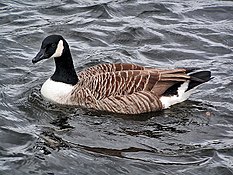 Canada goose
Canada goose.jpg) Mute swan
Mute swan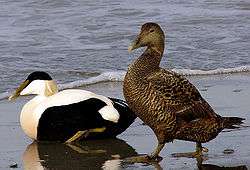 Common eider
Common eider
Pheasants, grouse, and allies
Order: Galliformes Family: Phasianidae
These are terrestrial species of gamebirds, feeding and nesting on the ground. They are variable in size but generally plump, with broad and relatively short wings.
- Common quail, Coturnix coturnix
- Ring-necked pheasant, Phasianus colchicus (I)
- Gray partridge, Perdix perdix
- Western capercaillie, Tetrao urogallus
- Black grouse, Tetrao tetrix
- Hazel grouse, Bonasa bonasia
- Willow ptarmigan, Lagopus lagopus
- Rock ptarmigan, Lagopus muta
Grebes

Order: Podicipediformes Family: Podicipedidae
Grebes are small to medium-large freshwater diving birds. They have lobed toes and are excellent swimmers and divers. However, they have their feet placed far back on the body, making them quite ungainly on land.
- Little grebe, Tachybaptus ruficollis
- Horned grebe, Podiceps auritus
- Red-necked grebe, Podiceps grisegena
- Great crested grebe, Podiceps cristatus
- Eared grebe, Podiceps nigricollis
Pigeons and doves

Order: Columbiformes Family: Columbidae
Pigeons and doves are stout-bodied birds with short necks and short slender bills with a fleshy cere.
- Rock pigeon, Columba livia
- Stock dove, Columba oenas
- Common wood-pigeon, Columba palumbus
- European turtle-dove, Streptopelia turtur
- Oriental turtle-dove, Streptopelia orientalis (A)
- Eurasian collared-dove, Streptopelia decaocto
- Mourning dove, Zenaida macroura (A)
Sandgrouse
Order: Pterocliformes Family: Pteroclidae
Sandgrouse have small pigeon-like heads and necks, but sturdy compact bodies. They have long pointed wings and sometimes tails and a fast direct flight. Flocks fly to watering holes at dawn and dusk. Their legs are feathered down to the toes.
- Pallas's sandgrouse, Syrrhaptes paradoxus (A)
Bustards
Order: Otidiformes Family: Otididae
Bustards are large terrestrial birds mainly associated with dry open country and steppes in the Old World. They are omnivorous and nest on the ground. They walk steadily on strong legs and big toes, pecking for food as they go. They have long broad wings with "fingered" wingtips and striking patterns in flight. Many have interesting mating displays.
- Great bustard, Otis tarda (A)
- Macqueen's bustard, Chlamydotis macqueenii (A)
- Little bustard, Tetrax tetrax (A)
Cuckoos
Order: Cuculiformes Family: Cuculidae
The family Cuculidae includes cuckoos, roadrunners, and anis. These birds are of variable size with slender bodies, long tails, and strong legs. The Old World cuckoos are brood parasites.
- Great spotted cuckoo, Clamator glandarius (A)
- Common cuckoo, Cuculus canorus
Nightjars and allies
Order: Caprimulgiformes Family: Caprimulgidae
Nightjars are medium-sized nocturnal birds that usually nest on the ground. They have long wings, short legs, and very short bills. Most have small feet, of little use for walking, and long pointed wings. Their soft plumage is camouflaged to resemble bark or leaves.
- Eurasian nightjar, Caprimulgus europaeus
- Egyptian nightjar, Caprimulgus aegyptius (A)
Swifts
Order: Caprimulgiformes Family: Apodidae
Swifts are small birds which spend the majority of their lives flying. These birds have very short legs and never settle voluntarily on the ground, perching instead only on vertical surfaces. Many swifts have long swept-back wings which resemble a crescent or boomerang.
- Chimney swift, Chaetura pelagica (A)
- White-throated needletail, Hirundapus caudacutus (A)
- Alpine swift, Apus melba (A)
- Common swift, Apus apus
- Pallid swift, Apus pallidus (A)
- Pacific swift, Apus pacificus (A)
- Little swift, Apus affinis (A)
- White-rumped swift, Apus caffer (A)
Rails, gallinules, and coots
.jpg)
Order: Gruiformes Family: Rallidae
Rallidae is a large family of small to medium-sized birds which includes the rails, crakes, coots, and gallinules. Typically they inhabit dense vegetation in damp environments near lakes, swamps, or rivers. In general they are shy and secretive birds, making them difficult to observe. Most species have strong legs and long toes which are well adapted to soft uneven surfaces. They tend to have short, rounded wings and to be weak fliers.
- Water rail, Rallus aquaticus
- Corn crake, Crex crex
- Sora, Porzana carolina (A)
- Spotted crake, Porzana porzana
- Eurasian moorhen, Gallinula chloropus
- Eurasian coot, Fulica atra
- Little crake, Zapornia parva
- Baillon's crake, Zapornia pusilla (A)
Cranes
.jpg)
Order: Gruiformes Family: Gruidae
Cranes are large, long-legged, and long-necked birds. Unlike the similar-looking but unrelated herons, cranes fly with necks outstretched, not pulled back. Most have elaborate and noisy courting displays or "dances".
- Demoiselle crane, Anthropoides virgo (A)
- Sandhill crane, Antigone canadensis (A)
- Common crane, Grus grus
Thick-knees
Order: Charadriiformes Family: Burhinidae
The thick-knees are a group of waders found worldwide within the tropical zone, with some species also breeding in temperate Europe and Australia. They are medium to large waders with strong black or yellow-black bills, large yellow eyes, and cryptic plumage. Despite being classed as waders, most species have a preference for arid or semi-arid habitats.
- Eurasian thick-knee, Burhinus oedicnemus (A)
Stilts and avocets
Order: Charadriiformes Family: Recurvirostridae
Recurvirostridae is a family of large wading birds which includes the avocets and stilts. The avocets have long legs and long up-curved bills. The stilts have extremely long legs and long, thin, straight bills.
- Black-winged stilt, Himantopus himantopus (A)
- Pied avocet, Recurvirostra avosetta
Oystercatchers
Order: Charadriiformes Family: Haematopodidae
The oystercatchers are large and noisy plover-like birds, with strong bills used for smashing or prising open molluscs.
- Eurasian oystercatcher, Haematopus ostralegus
Plovers and lapwings
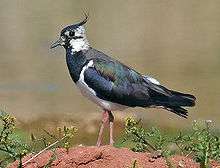
Order: Charadriiformes Family: Charadriidae
The family Charadriidae includes the plovers, dotterels, and lapwings. They are small to medium-sized birds with compact bodies, short thick necks, and long, usually pointed, wings. They are found in open country worldwide, mostly in habitats near water.
- Black-bellied plover, Pluvialis squatarola
- European golden-plover, Pluvialis apricaria
- American golden-plover, Pluvialis dominica (A)
- Pacific golden-plover, Pluvialis fulva (A)
- Northern lapwing, Vanellus vanellus
- Sociable lapwing, Vanellus gregarius (A)
- White-tailed lapwing, Vanellus leucurus (A)
- Lesser sand-plover, Charadrius mongolus (A)
- Greater sand-plover, Charadrius leschenaultii (A)
- Caspian plover, Charadrius asiaticus (A)
- Kentish plover, Charadrius alexandrinus
- Common ringed plover, Charadrius hiaticula
- Little ringed plover, Charadrius dubius
- Eurasian dotterel, Charadrius morinellus
Sandpipers and allies

Order: Charadriiformes Family: Scolopacidae
Scolopacidae is a large diverse family of small to medium-sized shorebirds including the sandpipers, curlews, godwits, shanks, tattlers, woodcocks, snipes, dowitchers, and phalaropes. The majority of these species eat small invertebrates picked out of the mud or soil. Variation in length of legs and bills enables multiple species to feed in the same habitat, particularly on the coast, without direct competition for food.
- Upland sandpiper, Bartramia longicauda (A)
- Whimbrel, Numenius phaeopus
- Little curlew, Numenius minutus (A)
- Eurasian curlew, Numenius arquata
- Bar-tailed godwit, Limosa lapponica
- Black-tailed godwit, Limosa limosa
- Hudsonian godwit, Limosa haemastica (A)
- Ruddy turnstone, Arenaria interpres
- Great knot, Calidris tenuirostris (A)
- Red knot, Calidris canutus
- Ruff, Calidris pugnax
- Broad-billed sandpiper, Calidris falcinellus
- Sharp-tailed sandpiper, Calidris acuminata (A)
- Stilt sandpiper, Calidris himantopus (A)
- Curlew sandpiper, Calidris ferruginea
- Temminck's stint, Calidris temminckii
- Long-toed stint, Calidris subminuta (A)
- Red-necked stint, Calidris ruficollis (A)
- Sanderling, Calidris alba
- Dunlin, Calidris alpina
- Purple sandpiper, Calidris maritima
- Baird's sandpiper, Calidris bairdii (A)
- Little stint, Calidris minuta
- White-rumped sandpiper, Calidris fuscicollis (A)
- Buff-breasted sandpiper, Calidris subruficollis
- Pectoral sandpiper, Calidris melanotos
- Semipalmated sandpiper, Calidris pusilla (A)
- Western sandpiper, Calidris mauri (A)
- Short-billed dowitcher, Limnodromus griseus (A)
- Long-billed dowitcher, Limnodromus scolopaceus (A)
- Jack snipe, Lymnocryptes minimus
- Eurasian woodcock, Scolopax rusticola
- Great snipe, Gallinago media
- Common snipe, Gallinago gallinago
- Terek sandpiper, Xenus cinereus
- Wilson's phalarope, Phalaropus tricolor (A)
- Red-necked phalarope, Phalaropus lobatus
- Red phalarope, Phalaropus fulicarius
- Common sandpiper, Actitis hypoleucos
- Spotted sandpiper, Actitis macularius (A)
- Green sandpiper, Tringa ochropus
- Solitary sandpiper, Tringa solitaria (A)
- Gray-tailed tattler, Tringa brevipes (A)
- Spotted redshank, Tringa erythropus
- Greater yellowlegs, Tringa melanoleuca (A)
- Common greenshank, Tringa nebularia
- Lesser yellowlegs, Tringa flavipes (A)
- Marsh sandpiper, Tringa stagnatilis
- Wood sandpiper, Tringa glareola
- Common redshank, Tringa totanus
Pratincoles and coursers
Order: Charadriiformes Family: Glareolidae
Glareolidae is a family of wading birds comprising the pratincoles, which have short legs, long pointed wings, and long forked tails, and the coursers, which have long legs, short wings, and long, pointed bills which curve downwards.
- Cream-colored courser, Cursorius cursor (A)
- Collared pratincole, Glareola pratincola (A)
- Oriental pratincole, Glareola maldivarum (A)
- Black-winged pratincole, Glareola nordmanni (A)
Skuas and jaegers
Order: Charadriiformes Family: Stercorariidae
The family Stercorariidae are, in general, medium to large sea birds, typically with gray or brown plumage, often with white markings on the wings. They nest on the ground in temperate and arctic regions and are long-distance migrants.
- Great skua, Stercorarius skua
- Pomarine jaeger, Stercorarius pomarinus
- Parasitic jaeger, Stercorarius parasiticus
- Long-tailed jaeger, Stercorarius longicaudus
Auks, murres, and puffins
Order: Charadriiformes Family: Alcidae
Alcidae are a family of seabirds which are superficially similar to penguins with their black-and-white colors, their upright posture, and some of their habits, but which are able to fly.
- Dovekie, Alle alle
- Common murre, Uria aalge
- Thick-billed murre, Uria lomvia (A)
- Razorbill, Alca torda
- Great auk, Pinguinus impennis (A) (extinct)
- Black guillemot, Cepphus grylle
- Parakeet auklet, Aethia psittacula (A)
- Atlantic puffin, Fratercula arctica
- Tufted puffin, Fratercula cirrhata (A)
Gulls, terns, and skimmers
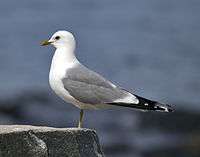
.jpg)
Order: Charadriiformes Family: Laridae
Laridae is a family of medium to large seabirds and includes gulls, terns, and skimmers. Gulls are typically gray or white, often with black markings on the head or wings. They have stout, longish, bills and webbed feet. Terns are a group of generally medium to large seabirds typically with gray or white plumage, often with black markings on the head. Most terns hunt fish by diving but some pick insects off the surface of fresh water. Terns are generally long-lived birds, with several species known to live in excess of 30 years.
- Black-legged kittiwake, Rissa tridactyla
- Ivory gull, Pagophila eburnea (A)
- Sabine's gull, Xema sabini
- Slender-billed gull, Chroicocephalus genei (A)
- Bonaparte's gull, Chroicocephalus philadelphia (A)
- Black-headed gull, Chroicocephalus ridibundus
- Little gull, Hydrocoloeus minutus
- Ross's gull, Rhodostethia rosea (A)
- Laughing gull, Leucophaeus atricilla (A)
- Franklin's gull, Leucophaeus pipixcan (A)
- Mediterranean gull, Ichthyaetus melanocephalus
- Pallas's gull, Ichthyaetus ichthyaetus (A)
- Mew gull, Larus canus
- Ring-billed gull, Larus delawarensis (A)
- Herring gull, Larus argentatus
- Yellow-legged gull, Larus michahellis
- Caspian gull, Larus cachinnans
- Iceland gull, Larus glaucoides (A)
- Lesser black-backed gull, Larus fuscus
- Glaucous gull, Larus hyperboreus
- Great black-backed gull, Larus marinus
- Sooty tern, Onychoprion fuscatus (A)
- Bridled tern, Onychoprion anaethetus (A)
- Little tern, Sternula albifrons
- Gull-billed tern, Gelochelidon nilotica (A)
- Caspian tern, Hydroprogne caspia
- Black tern, Chlidonias niger
- White-winged tern, Chlidonias leucopterus
- Whiskered tern, Chlidonias hybrida (A)
- Roseate tern, Sterna dougallii (A)
- Common tern, Sterna hirundo
- Arctic tern, Sterna paradisaea
- Forster's tern, Sterna forsteri (A)
- Sandwich tern, Thalasseus sandvicensis
Loons
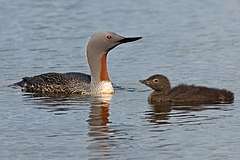
Order: Gaviiformes Family: Gaviidae
Loons are a group of aquatic birds found in many parts of North America and Northern Europe. They are the size of a large duck or small goose, which they somewhat resemble in shape when swimming, but to which they are completely unrelated. In particular, loons' legs are set very far back which assists swimming underwater but makes walking on land extremely difficult.
- Red-throated loon, Gavia stellata
- Arctic loon, Gavia arctica
- Pacific loon, Gavia pacifica (A)
- Common loon, Gavia immer
- Yellow-billed loon, Gavia adamsii
Albatrosses
Order: Procellariiformes Family: Diomedeidae
The albatrosses are among the largest of flying birds, and the great albatrosses of the genus Diomedea have the largest wingspans of any extant birds.
- Yellow-nosed albatross, Thalassarche chlororhynchos (A)
- Black-browed albatross, Thalassarche melanophris (A)
Northern storm-petrels
Order: Procellariiformes Family: Hydrobatidae
Though the members of this family are similar in many respects to the southern storm-petrels, including their general appearance and habits, there are enough genetic differences to warrant their placement in a separate family.
- European storm-petrel, Hydrobates pelagicus
- Leach's storm-petrel, Oceanodroma leucorhoa
Shearwaters and petrels

Order: Procellariiformes Family: Procellariidae
The procellariids are the main group of medium-sized "true petrels", characterised by united nostrils with medium septum and a long outer functional prima
- Northern fulmar, Fulmarus glacialis
- Petrel species, Pterodroma sp. (A)
- Cory's shearwater, Calonectris borealis (A)
- Great shearwater, Ardenna gravis (A)
- Sooty shearwater, Ardenna griseus
- Manx shearwater, Puffinus puffinus
- Balearic shearwater, Puffinus mauretanicus (A)
Storks
Order: Ciconiiformes Family: Ciconiidae
Storks are large, long-legged, long-necked, wading birds with long, stout bills. Storks are mute, but bill-clattering is an important mode of communication at the nest. Their nests can be large and may be reused for many years. Many species are migratory.
- Black stork, Ciconia nigra
- White stork, Ciconia ciconia
Frigatebirds
Order: Suliformes Family: Fregatidae
Frigatebirds are large seabirds usually found over tropical oceans. They are large, black, or black-and-white, with long wings and deeply forked tails. The males have colored inflatable throat pouches. They do not swim or walk and cannot take off from a flat surface. Having the largest wingspan-to-body-weight ratio of any bird, they are essentially aerial, able to stay aloft for more than a week.
- Frigatebird species, Fregata sp. (A)
Boobies and gannets
Order: Suliformes Family: Sulidae
The sulids comprise the gannets and boobies. Both groups are medium-large coastal seabirds that plunge-dive for fish.
- Northern gannet, Morus bassanus
Cormorants and shags
Order: Suliformes Family: Phalacrocoracidae
Cormorants and shags are medium-to-large aquatic birds, usually with mainly dark plumage and areas of colored skin on the face. The bill is long, thin and sharply hooked. Their feet are four-toed and webbed.
- Pygmy cormorant, Microcarbo pygmeus (A)
- Great cormorant, Phalacrocorax carbo
- European shag, Phalacrocorax aristotelis
Herons, egrets, and bitterns
Order: Pelecaniformes Family: Ardeidae
The family Ardeidae contains the herons, egrets, and bitterns. Herons and egrets are medium to large wading birds with long necks and legs. Bitterns tend to be shorter necked and more secretive. Members of Ardeidae fly with their necks retracted, unlike other long-necked birds such as storks, ibises and spoonbills.
- American bittern, Botaurus lentiginosus (A)
- Great bittern, Botaurus stellaris
- Little bittern, Ixobrychus minutus (A)
- Gray heron, Ardea cinerea
- Purple heron, Ardea purpurea (A)
- Great egret, Ardea alba
- Little egret, Egretta garzetta (A)
- Cattle egret, Bubulcus ibis (A)
- Squacco heron, Ardeola ralloides (A)
- Black-crowned night-heron, Nycticorax nycticorax (A)
Ibises and spoonbills
Order: Pelecaniformes Family: Threskiornithidae
The family Threskiornithidae includes the ibises and spoonbills. They have long, broad wings. Their bodies tend to be elongated, the neck more so, with rather long legs. The bill is also long, decurved in the case of the ibises, straight and distinctively flattened in the spoonbills.
- Glossy ibis, Plegadis falcinellus (A)
- Eurasian spoonbill, Platalea leucorodia
Osprey
Order: Accipitriformes Family: Pandionidae
Pandionidae is a family of fish-eating birds of prey, possessing a very large, powerful hooked beak for tearing flesh from their prey, strong legs, powerful talons, and keen eyesight. The family is monotypic.
- Osprey, Pandion haliaetus
Hawks, eagles, and kites


Order: Accipitriformes Family: Accipitridae
Accipitridae is a family of birds of prey and includes hawks, eagles, kites, harriers, and Old World vultures. These birds have very large powerful hooked beaks for tearing flesh from their prey, strong legs, powerful talons, and keen eyesight.
- Black-winged kite, Elanus caeruleus (A)
- Egyptian vulture, Neophron percnopterus (A)
- European honey-buzzard, Pernis apivorus
- Cinereous vulture, Aegypius monachus (A)
- Eurasian griffon, Gyps fulvus (A)
- Short-toed snake-eagle, Circaetus gallicus (A)
- Lesser spotted eagle, Clanga pomarina
- Greater spotted eagle, Clanga clanga
- Booted eagle, Hieraaetus pennatus (A)
- Steppe eagle, Aquila nipalensis (A)
- Imperial eagle, Aquila heliaca (A)
- Golden eagle, Aquila chrysaetos
- Eurasian marsh-harrier, Circus aeruginosus
- Hen harrier, Circus cyaneus
- Pallid harrier, Circus macrourus
- Montagu's harrier, Circus pygargus
- Eurasian sparrowhawk, Accipiter nisus
- Northern goshawk, Accipiter gentilis
- Red kite, Milvus milvus
- Black kite, Milvus migrans
- White-tailed eagle, Haliaeetus albicilla
- Rough-legged hawk, Buteo lagopus
- Common buzzard, Buteo buteo
- Long-legged buzzard, Buteo rufinus (A)
Barn-owls
Order: Strigiformes Family: Tytonidae
Barn-owls are medium to large owls with large heads and characteristic heart-shaped faces. They have long strong legs with powerful talons.
- Barn owl, Tyto alba
Owls
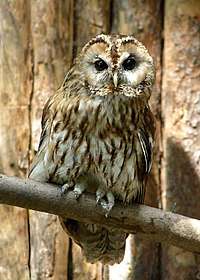
Order: Strigiformes Family: Strigidae
Typical owls are small to large solitary nocturnal birds of prey. They have large forward-facing eyes and ears, a hawk-like beak, and a conspicuous circle of feathers around each eye called a facial disk.
- Eurasian scops-owl, Otus scops (A)
- Eurasian eagle-owl, Bubo bubo
- Snowy owl, Bubo scandiacus
- Northern hawk owl, Surnia ulula
- Eurasian pygmy-owl, Glaucidium passerinum
- Little owl, Athene noctua (A)
- Tawny owl, Strix aluco
- Ural owl, Strix uralensis
- Great gray owl, Strix nebulosa
- Long-eared owl, Asio otus
- Short-eared owl, Asio flammeus
- Boreal owl, Aegolius funereus
Hoopoes
Order: Bucerotiformes Family: Upupidae
Hoopoes have black, white and orangey-pink colouring with a large erectile crest on their head.
- Eurasian hoopoe, Upupa epops
Kingfishers
Order: Coraciiformes Family: Alcedinidae
Kingfishers are medium-sized birds with large heads, long, pointed bills, short legs and stubby tails.
- Common kingfisher, Alcedo atthis
Bee-eaters
Order: Coraciiformes Family: Meropidae
The bee-eaters are a group of near passerine birds in the family Meropidae. Most species are found in Africa but others occur in southern Europe, Madagascar, Australia and New Guinea. They are characterised by richly coloured plumage, slender bodies and usually elongated central tail feathers. All are colourful and have long downturned bills and pointed wings, which give them a swallow-like appearance when seen from afar.
- Blue-cheeked bee-eater, Merops persicus (A)
- European bee-eater, Merops apiaster
Rollers
Order: Coraciiformes Family: Coraciidae
Rollers resemble crows in size and build, but are more closely related to the kingfishers and bee-eaters. They share the colourful appearance of those groups with blues and browns predominating. The two inner front toes are connected, but the outer toe is not.
- European roller, Coracias garrulus
Woodpeckers

Order: Piciformes Family: Picidae
Woodpeckers are small to medium-sized birds with chisel-like beaks, short legs, stiff tails and long tongues used for capturing insects. Some species have feet with two toes pointing forward and two backward, while several species have only three toes. Many woodpeckers have the habit of tapping noisily on tree trunks with their beaks.
- Eurasian wryneck, Jynx torquilla
- Eurasian three-toed woodpecker, Picoides tridactylus
- Middle spotted woodpecker, Dendrocoptes medius (A)
- White-backed woodpecker, Dendrocopos leucotos
- Great spotted woodpecker, Dendrocopos major
- Lesser spotted woodpecker, Dryobates minor
- Eurasian green woodpecker, Picus viridis
- Gray-headed woodpecker, Picus canus
- Black woodpecker, Dryocopus martius
Falcons and caracaras
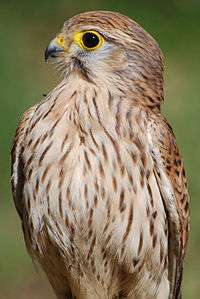
Order: Falconiformes Family: Falconidae
Falconidae is a family of diurnal birds of prey. They differ from hawks, eagles and kites in that they kill with their beaks instead of their talons.
- Lesser kestrel, Falco naumanni (A)
- Eurasian kestrel, Falco tinnunculus
- Red-footed falcon, Falco vespertinus
- Amur falcon, Falco amurensis (A)
- Eleonora's falcon, Falco eleonorae (A)
- Merlin, Falco columbarius
- Eurasian hobby, Falco subbuteo
- Saker falcon, Falco cherrug (A)
- Gyrfalcon, Falco rusticolus
- Peregrine falcon, Falco peregrinus
Old World orioles
Order: Passeriformes Family: Oriolidae
The Old World orioles are colourful passerine birds. They are not related to the New World orioles.
- Eurasian golden oriole, Oriolus oriolus
Shrikes
Order: Passeriformes Family: Laniidae
Shrikes are passerine birds known for their habit of catching other birds and small animals and impaling the uneaten portions of their bodies on thorns. A shrike's beak is hooked, like that of a typical bird of prey.
- Red-backed shrike, Lanius collurio
- Red-tailed shrike, Lanius phoenicuroides (A)
- Isabelline shrike, Lanius isabellinus (A)
- Brown shrike, Lanius cristatus (A)
- Long-tailed shrike, Lanius schach (A)
- Great gray shrike, Lanius excubitor
- Northern shrike, Lanius borealis (A)
- Lesser gray shrike, Lanius minor
- Masked shrike, Lanius nubicus (A)
- Woodchat shrike, Lanius senator (A)
Crows, jays, and magpies
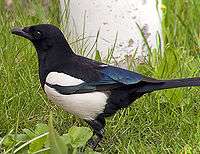
Order: Passeriformes Family: Corvidae
The family Corvidae includes crows, ravens, jays, choughs, magpies, treepies, nutcrackers, and ground jays. Corvids are above average in size among the Passeriformes, and some of the larger species show high levels of intelligence.
- Siberian jay, Perisoreus infaustus
- Eurasian jay, Garrulus glandarius
- Eurasian magpie, Pica pica
- Eurasian nutcracker, Nucifraga caryocatactes
- Eurasian jackdaw, Corvus monedula
- Daurian jackdaw, Corvus dauuricus (A)
- Rook, Corvus frugilegus
- Carrion crow, Corvus corone
- Hooded crow, Corvus cornix[2]
- Common raven, Corvus corax
Tits, chickadees, and titmice

Order: Passeriformes Family: Paridae
The Paridae are mainly small stocky woodland species with short stout bills. Some have crests. They are adaptable birds, with a mixed diet including seeds and insects.
- Coal tit, Periparus ater
- Crested tit, Lophophanes cristatus
- Marsh tit, Poecile palustris
- Willow tit, Poecile montanus
- Gray-headed chickadee, Poecile cinctus
- Eurasian blue tit, Cyanistes caeruleus
- Azure tit, Cyanistes cyanus (A)
- Great tit, Parus major
Penduline-tits
Order: Passeriformes Family: Remizidae
The penduline-tits are a group of small passerine birds related to the true tits. They are insectivores.
- Eurasian penduline-tit, Remiz pendulinus
Larks
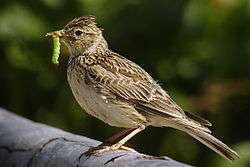
Order: Passeriformes Family: Alaudidae
Larks are small terrestrial birds with often extravagant songs and display flights. Most larks are fairly dull in appearance. Their food is insects and seed
- Horned lark, Eremophila alpestris
- Greater short-toed lark, Calandrella brachydactyla
- Bimaculated lark, Melanocorypha bimaculata (A)
- Calandra lark, Melanocorypha calandra (A)
- Black lark, Melanocorypha yeltoniensis (A)
- Lesser short-toed lark, Alaudala rufescens (A)
- Wood lark, Lullula arborea
- White-winged lark, Alauda leucoptera (A)
- Eurasian skylark, Alauda arvensis
- Crested lark, Galerida cristata
Bearded reedling
Order: Passeriformes Family: Panuridae
This species, the only one in its family, is found in reed beds throughout temperate Europe and Asia.
- Bearded reedling, Panurus biarmicus
Cisticolas and allies
Order: Passeriformes Family: Cisticolidae
The Cisticolidae are warblers found mainly in warmer southern regions of the Old World. They are generally very small birds of drab brown or gray appearance found in open country such as grassland or scrub.
- Zitting cisticola, Cisticola juncidis (A)
Reed warblers and allies
Order: Passeriformes Family: Acrocephalidae
The members of this family are usually rather large for "warblers". Most are rather plain olivaceous brown above with much yellow to beige below. They are usually found in open woodland, reedbeds, or tall grass. The family occurs mostly in southern to western Eurasia and surroundings, but it also ranges far into the Pacific, with some species in Africa.
- Booted warbler, Iduna caligata (A)
- Sykes's warbler, Iduna rama (A)
- Eastern olivaceous warbler, Iduna pallida (A)
- Western olivaceous warbler, Iduna opaca (A)
- Melodious warbler, Hippolais polyglotta (A)
- Icterine warbler, Hippolais icterina
- Aquatic warbler, Acrocephalus paludicola (A)
- Sedge warbler, Acrocephalus schoenobaenus
- Paddyfield warbler, Acrocephalus agricola (A)
- Blyth's reed warbler, Acrocephalus dumetorum
- Marsh warbler, Acrocephalus palustris
- Eurasian reed warbler, Acrocephalus scirpaceus
- Great reed warbler, Acrocephalus arundinaceus
Grassbirds and allies
Order: Passeriformes Family: Locustellidae
Locustellidae are a family of small insectivorous songbirds found mainly in Eurasia, Africa, and the Australian region. They are smallish birds with tails that are usually long and pointed, and tend to be drab brownish or buffy all over.
- Pallas's grasshopper-warbler, Locustella certhiola (A)
- Lanceolated warbler, Locustella lanceolata (A)
- River warbler, Locustella fluviatilis
- Savi's warbler, Locustella luscinioides
- Common grasshopper-warbler, Locustella naevia
Swallows

Order: Passeriformes Family: Hirundinidae
The family Hirundinidae is adapted to aerial feeding. They have a slender streamlined body, long pointed wings, and a short bill with a wide gape. The feet are adapted to perching rather than walking, and the front toes are partially joined at the base.
- Bank swallow, Riparia riparia
- Eurasian crag-martin, Ptyonoprogne rupestris (A)
- Barn swallow, Hirundo rustica
- Red-rumped swallow, Cecropis daurica
- Cliff swallow, Petrochelidon pyrrhonota (A)
- Common house-martin, Delichon urbicum
Leaf warblers
Order: Passeriformes Family: Phylloscopidae
Leaf warblers are a family of small insectivorous birds found mostly in Eurasia and ranging into Wallacea and Africa. The species are of various sizes, often green-plumaged above and yellow below, or more subdued with grayish-green to grayish-brown colors.
- Wood warbler, Phylloscopus sibilatrix
- Western Bonelli's warbler, Phylloscopus bonelli (A)
- Eastern Bonelli's warbler, Phylloscopus orientalis (A)
- Yellow-browed warbler, Phylloscopus inornatus
- Hume's warbler, Phylloscopus humei (A)
- Pallas's leaf warbler, Phylloscopus proregulus
- Radde's warbler, Phylloscopus schwarzi (A)
- Dusky warbler, Phylloscopus fuscatus
- Plain leaf warbler, Phylloscopus neglectus (A)
- Willow warbler, Phylloscopus trochilus
- Common chiffchaff, Phylloscopus collybita
- Iberian chiffchaff, Phylloscopus ibericus (A)
- Green warbler, Phylloscopus nitidus (A)
- Greenish warbler, Phylloscopus trochiloides
- Two-barred warbler, Phylloscopus plumbeitarsus (A)
- Arctic warbler, Phylloscopus borealis
Bush warblers and allies
Order: Passeriformes Family: Scotocercidae
The members of this family are found throughout Africa, Asia, and Polynesia. Their taxonomy is in flux, and some authorities place some genera in other families.[4]
- Cetti's warbler, Cettia cetti (A)
Long-tailed tits
Order: Passeriformes Family: Aegithalidae
Long-tailed tits are a group of small passerine birds with medium to long tails. They make woven bag nests in trees. Most eat a mixed diet which includes insec
- Long-tailed tit, Aegithalos caudatus
Sylviid warblers, parrotbills, and allies
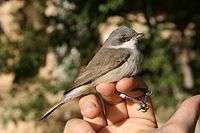
Order: Passeriformes Family: Sylviidae
The family Sylviidae is a group of small insectivorous birds. They mainly occur as breeding species, as another common name (Old World warblers) implies, in Europe, Asia and, to a lesser extent, Africa. Most are of generally undistinguished appearance, but many have distinctive songs.
- Eurasian blackcap, Sylvia atricapilla
- Garden warbler, Sylvia borin
- Asian desert warbler, Sylvia nana (A)
- Barred warbler, Sylvia nisoria
- Lesser whitethroat, Sylvia curruca
- Subalpine warbler, Sylvia cantillans (A)
- Moltoni's warbler, Sylvia subalpina (A)
- Sardinian warbler, Sylvia melanocephala (A)
- Greater whitethroat, Sylvia communis
- Dartford warbler, Sylvia undata (A)
Kinglets
Order: Passeriformes Family: Regulidae
The kinglets and "crests" are a small family of birds which resemble some warblers. They are very small insectivorous birds in the single genus Regulus. The adults have colored crowns, giving rise to their name.
- Goldcrest, Regulus regulus
- Common firecrest, Regulus ignicapilla
Nuthatches
Order: Passeriformes Family: Sittidae
Nuthatches are small woodland birds. They have the unusual ability to climb down trees head first, unlike other birds which can only go upwards. Nuthatches have big heads, short tails, and powerful bills and feet.
- Eurasian nuthatch, Sitta europaea
Treecreepers
Order: Passeriformes Family: Certhiidae
Treecreepers are small woodland birds, brown above and white below. They have thin pointed down-curved bills, which they use to extricate insects from bark. They have stiff tail feathers, like woodpeckers, which they use to support themselves on vertical trees.
- Eurasian treecreeper, Certhia familiaris
- Short-toed treecreeper, Certhia brachydactyla (A)
Wrens
Order: Passeriformes Family: Troglodytidae
The wrens are mainly small and inconspicuous except for their loud songs. These birds have short wings and thin down-turned bills. Several species often hold their tails upright. All are insectivorous.
- Eurasian wren, Troglodytes troglodytes
Dippers
Order: Passeriformes Family: Cinclidae
Dippers are a group of perching birds whose habitat includes aquatic environments in the Americas, Europe, and Asia. They are named for their bobbing or dipping movements.
- White-throated dipper, Cinclus cinclus
Starlings
Order: Passeriformes Family: Sturnidae
Starlings are small to medium-sized passerine birds. Their flight is strong and direct and they are very gregarious. Their preferred habitat is fairly open country. They eat insects and fruit. Their plumage is typically dark with a metallic sheen.
- European starling, Sturnus vulgaris
- Rosy starling, Pastor roseus
Thrushes and allies
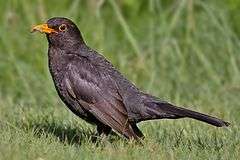
Order: Passeriformes Family: Turdidae
The thrushes are a family of birds that occur mainly in the Old World. They are plump, soft-plumaged, small-to-medium-sized insectivores or sometimes omnivores, often feeding on the ground. Many have attractive songs.
- Siberian thrush, Geokichla sibirica (A)
- White's thrush, Zoothera aurea (A)
- Veery, Catharus fuscescens (A)
- Swainson's thrush, Catharus ustulatus (A)
- Hermit thrush, Catharus guttatus (A)
- Mistle thrush, Turdus viscivorus
- Song thrush, Turdus philomelos
- Redwing, Turdus iliacus
- Eurasian blackbird, Turdus merula
- American robin, Turdus migratorius (A)
- Eyebrowed thrush, Turdus obscurus (A)
- Fieldfare, Turdus pilaris
- Ring ouzel, Turdus torquatus
- Black-throated thrush, Turdus atrogularis (A)
- Dusky thrush, Turdus eunomus (A)
Old World flycatchers

Order: Passeriformes Family: Muscicapidae
Old World flycatchers are a large group of birds which are mainly small arboreal insectivores. The appearance of these birds is highly varied, but they mostly have weak songs and harsh calls.
- Asian brown flycatcher, Muscicapa latirostris (A)
- Spotted flycatcher, Muscicapa striata
- European robin, Erithacus rubecula
- White-throated robin, Irania gutturalis (A)
- Thrush nightingale, Luscinia luscinia
- Common nightingale, Luscinia megarhynchos (A)
- Bluethroat, Luscinia svecica
- Red-flanked bluetail, Tarsiger cyanurus (A)
- Taiga flycatcher, Ficedula albicilla (A)
- Red-breasted flycatcher, Ficedula parva
- European pied flycatcher, Ficedula hypoleuca
- Collared flycatcher, Ficedula albicollis
- Common redstart, Phoenicurus phoenicurus
- Black redstart, Phoenicurus ochruros
- Rufous-tailed rock-thrush, Monticola saxatilis (A)
- Blue rock-thrush, Monticola solitarius (A)
- Whinchat, Saxicola rubetra
- European stonechat, Saxicola rubicola
- Siberian stonechat, Saxicola maurus (A)
- Northern wheatear, Oenanthe oenanthe
- Isabelline wheatear, Oenanthe isabellina (A)
- Desert wheatear, Oenanthe deserti (A)
- Pied wheatear, Oenanthe pleschanka (A)
- Black-eared wheatear, Oenanthe hispanica (A)
Waxwings
Order: Passeriformes Family: Bombycillidae
The waxwings are a group of birds with soft silky plumage and unique red tips to some of the wing feathers. In the Bohemian and cedar waxwings, these tips look like sealing wax and give the group its name. These are arboreal birds of northern forests. They live on insects in summer and berries in winter.
- Bohemian waxwing, Bombycilla garrulus
Accentors
Order: Passeriformes Family: Prunellidae
The accentors are the only bird family which is endemic to the Palearctic. They are small, fairly drab species superficially similar to sparrows.
- Alpine accentor, Prunella collaris (A)
- Siberian accentor, Prunella montanella (A)
- Black-throated accentor, Prunella atrogularis (A)
- Dunnock, Prunella modularis
Old World sparrows
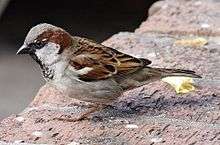
Order: Passeriformes Family: Passeridae
In general, Old World sparrows tend to be small, plump, brown or gray birds with short tails and short powerful beaks. Sparrows are seed eaters, but they also consume small insects.
- House sparrow, Passer domesticus
- Spanish sparrow, Passer hispaniolensis (A)
- Eurasian tree sparrow, Passer montanus
Wagtails and pipits

Order: Passeriformes Family: Motacillidae
Motacillidae is a family of small birds with medium to long tails which includes the wagtails, longclaws, and pipits. They are slender ground-feeding insectivores of open country.
- Gray wagtail, Motacilla cinerea
- Western yellow wagtail, Motacilla flava
- Citrine wagtail, Motacilla citreola
- White wagtail, Motacilla alba
- Richard's pipit, Anthus richardi
- Blyth's pipit, Anthus godlewskii (A)
- Tawny pipit, Anthus campestris
- Meadow pipit, Anthus pratensis
- Tree pipit, Anthus trivialis
- Olive-backed pipit, Anthus hodgsoni (A)
- Pechora pipit, Anthus gustavi (A)
- Red-throated pipit, Anthus cervinus
- Water pipit, Anthus spinoletta (A)
- Rock pipit, Anthus petrosus
- American pipit, Anthus rubescens (A)
Finches, euphonias, and allies
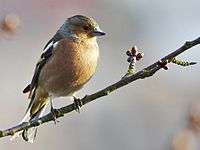
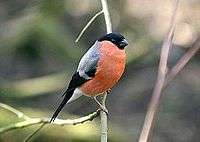
Order: Passeriformes Family: Fringillidae
Finches are seed-eating birds that are small to moderately large and have a strong beak, usually conical and in some species very large. All have twelve tail feathers and nine primaries. These birds have a bouncing flight with alternating bouts of flapping and gliding on closed wings, and most sing well.
- Common chaffinch, Fringilla coelebs
- Brambling, Fringilla montifringilla
- Hawfinch, Coccothraustes coccothraustes
- Common rosefinch, Carpodacus erythrinus
- Pine grosbeak, Pinicola enucleator
- Eurasian bullfinch, Pyrrhula pyrrhula
- Trumpeter finch, Bucanetes githagineus (A)
- European greenfinch, Chloris chloris
- Twite, Linaria flavirostris
- Eurasian linnet, Linaria cannabina
- Common redpoll, Acanthis flammea
- Parrot crossbill, Loxia pytyopsittacus
- Red crossbill, Loxia curvirostra
- White-winged crossbill, Loxia leucoptera
- European goldfinch, Carduelis carduelis
- European serin, Serinus serinus
- Eurasian siskin, Spinus spinus
Longspurs and snow buntings
Order: Passeriformes Family: Calcariidae
The Calcariidae are a family of birds that had been traditionally grouped with the New World sparrows, but differ in a number of respects and are usually found in open grassy areas.
- Lapland longspur, Calcarius lapponicus
- Snow bunting, Plectrophenax nivalis
Old World buntings
Order: Passeriformes Family: Emberizidae
Emberizidae is a family of passerine birds containing a single genus. Until 2017, the New World sparrows (Passerellidae) were also considered part of this family.
- Black-headed bunting, Emberiza melanocephala (A)
- Corn bunting, Emberiza calandra
- Chestnut-eared bunting, Emberiza fucata (A)
- Rock bunting, Emberiza cia (A)
- Cirl bunting, Emberiza cirlus (A)
- Yellowhammer, Emberiza citrinella
- Pine bunting, Emberiza leucocephalos (A)
- Gray-necked bunting, Emberiza buchanani (A)
- Ortolan bunting, Emberiza hortulana
- Cretzschmar's bunting, Emberiza caesia (A)
- Reed bunting, Emberiza schoeniclus
- Yellow-breasted bunting, Emberiza aureola (A)
- Little bunting, Emberiza pusilla
- Rustic bunting, Emberiza rustica
- Black-faced bunting, Emberiza spodocephala (A)
- Yellow-browed bunting, Emberiza chrysophrys (A)
New World sparrows
Order: Passeriformes Family: Passerellidae
Until 2017, these species were considered part of the family Emberizidae. Most of the species are known as sparrows, but these birds are not closely related to the Old World sparrows which are in the family Passeridae. Many of these have distinctive head patterns.
- American tree sparrow, Spizelloides arborea (A)
- Dark-eyed junco, Junco hyemalis (A)
- White-throated sparrow, Zonotrichia albicollis (A)
- Song sparrow, Melospiza melodia (A)
Cardinals and allies
Order: Passeriformes Family: Cardinalidae
The cardinals are a family of robust seed-eating birds with strong bills. They are typically associated with open woodland. The sexes usually have distinct plumages.
- Rose-breasted grosbeak, Pheucticus ludovicianus (A)
Notes
- The Birdlife Sverige list has only "bean goose" but eBird has records of both bean-goose species
References
- Jirle, Erling; Lagerqvist, Markus (10 April 2019). "Western Palearctic Birds ver 5". Birdlife Sverige. Retrieved 25 August 2019.
- "Sweden eBird Bar Chart". Cornell Lab of Ornithology. Retrieved 10 May 2020.
- Clements, J. F., T. S. Schulenberg, M. J. Iliff, S. M. Billerman, T. A. Fredericks, B. L. Sullivan, and C. L. Wood. 2019. The eBird/Clements Checklist of Birds of the World: v2019. Downloaded from http://www.birds.cornell.edu/clementschecklist/download/ Retrieved August 15, 2019
- Gill, F. and D. Donsker (Eds). 2019. IOC World Bird List (v 9.2). doi:10.14344/IOC.ML.9.2. http://www.worldbirdnames.org/ retrieved 22 June 2019
See also
External links
- Birds of Sweden - World Institute for Conservation and Environment